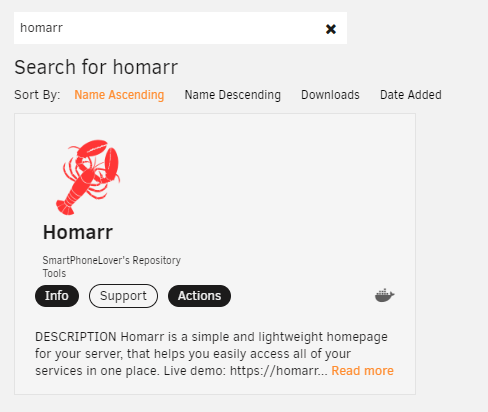🚀 Installation
Homarr can be installed in many ways. For most users, Installation using Docker will be sufficient and the easiest.
Installation using Docker
Docker is a free Software that isolates Homarr using containers. Using Docker, you can run Homarr on any supported platform (including Windows and Raspberry Pi), easily.
Prerequisites
Installation
To install Homarr using Docker, simply run the following command.
docker run \
--name homarr \
--restart unless-stopped \
-p 7575:7575 \
-v <your-path>/homarr/configs:/app/data/configs \
-v <your-path>/homarr/icons:/app/public/icons \
-d ghcr.io/ajnart/homarr:latest
Docker will mount the configuration files and icons to your host machine. Please make sure to replace <your-path> from the docker run command with your desired storage location. The path must be absolute.
Updating
To update Homarr, you must remove your container first. Make sure that you've mounted your data and that you have access to it, so your configuration doesn't get lost.
- Run
docker rm homarrto remove the container. - Pull the latest Homarr image
docker pull ghcr.io/ajnart/homarr:latest. - Re-run the command you used to install Homarr.
This process can get tideous, if you update frequently. Thus, we recommend the installation using docker-compose for more experienced users.
Want to update all your containers automatically? Checkout Watchtower a service which will automatically update your containers on a set interval.
Installation using Docker Compose or Portainer Stacks
Prerequisites
Installing
- Docker Compose
- Portainer Stacks
To install Homarr using Docker Compose, simply create a file called docker-compose.yml and paste the following code into it.
version: '3'
#---------------------------------------------------------------------#
# Homarr - A simple, yet powerful dashboard for your server. #
#---------------------------------------------------------------------#
services:
homarr:
container_name: homarr
image: ghcr.io/ajnart/homarr:latest
restart: unless-stopped
volumes:
- ./homarr/configs:/app/data/configs
- ./homarr/icons:/app/public/icons
ports:
- '7575:7575'
Then, run docker-compose up -d in the same directory. This will start the Homarr container in the background.
To install Homarr using Portainer Stacks, simply create a new stack and paste the following code into it.
version: '3'
#---------------------------------------------------------------------#
# Homarr - A simple, yet powerful dashboard for your server. #
#---------------------------------------------------------------------#
services:
homarr:
container_name: homarr
image: ghcr.io/ajnart/homarr:latest
restart: unless-stopped
volumes:
- <your-path>:/app/data/configs
- <your-path>:/app/public/icons
ports:
- '7575:7575'
Portainer will mount the configuration files and icons to your host machine. Please make sure to replace <your-path> from the docker run command with your desired storage location. The path must be absolute.
Then, click on Deploy the stack and wait until the container has started.
If you're unsure how to create a stack, checkout the Portainer Documentation.
Updating
To update Homarr using Docker Compose or Portainer Stacks, simply pull the latest image and restart the container.
- Run
docker pull ghcr.io/ajnart/homarr:latestto pull the latest image. - Re-run
docker-compose up -dor re-deploy the stack in Portainer.
Installation using the Unraid Community App Store
You can install Homarr directly from your Unraid Dashboard, no terminal required.
Prerequisites
Install the Community Apps Plugin
Open Installation GuideDon't know whether you have the plugin installed or not? Search for this tab in the navigation:
Installing
After you've installed the Community Apps Plugin, you can install Homarr from the Unraid Dashboard.
- Navigate to the tab "Apps".
- Search for "Homarr" and click on the result.
- Click on "Install" and adjust the settings to your liking.

After you've installed Homarr, you can find it under the tab "Docker".
The official support thread is located here, but we prefer to communicate over GitHub and Discord instead.
Installation on Synology
The installation process is quite easy and fast on Synology devices. Since this method is used less often, we recommend you to follow this guide written by mariushosting.
https://mariushosting.com/how-to-install-homarr-on-your-synology-nas/
This is a third party guide! It might not be up-to-date, nor do we offer official support.
Installation on QNAP
When installing on QNAP, we recommend you to install Homarr using Container Station or this third-party image.
There is also a guide available, but note that it is written in Chinese: https://post.smzdm.com/p/awzm7op2/
This is a unvalidated third party guide! It might not be up-to-date, nor do we offer official support.
Installation using Saltbox
You can also use this to install on Saltbox:
sb install sandbox-homarr
This is a unvalidated third party guide! It might not be up-to-date, nor do we offer official support.
Building from source
Installing Homarr from source is not recommended and only intended for developers and contributors, please use the Docker installation method instead.
- Yarn Package Manager
- NPM Package Manager
- Clone the Repository using
git clone https://github.com/ajnart/homarr.git - Enter the created directory using
cd homarr - Install all dependencies using
yarn install - Build the source using
yarn build - Start the NextJS web server using
yarn start - Alternatively, use
yarn devto run a live development server.
- Clone the Repository using
git clone https://github.com/ajnart/homarr.git - Enter the created directory using
cd homarr - Install all dependencies using
npm install - Build the source using
npm build - Start the NextJS web server using
npm start - Alternatively, use
npm run devto run a live development server.
Troubleshooting
Having trouble installing Homarr on your system? Check out our FAQ and Known Issues. If you are still running into issues, please contact us in our Discord server.
Anything else in mind?
Have you installed Homarr using a different method? Please share it with us, so we can expand to a bigger userbase!